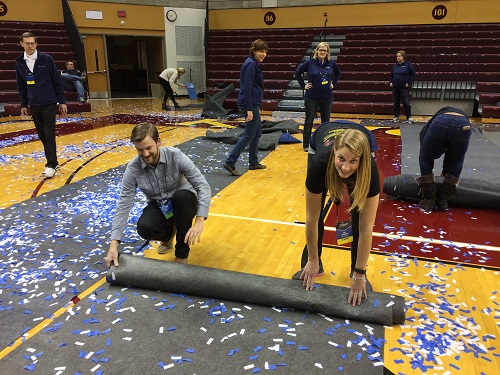

Regardless of the sport, there is one common denominator in every event – volunteers. How and where you recruit, match skills, incentivize and communicate with volunteers can make all the difference in hosting a successful versus chaotic volunteer program.
Following are some tips that I have observed through years of managing events and their respective volunteer programs for national rights holders at the West Michigan Sports Commission.
Find the Right Volunteers
The process starts with finding your volunteer base.
• Find the enthusiasts – The most obvious place to look is the local club of your organization. For example, USA Softball regularly hosts events in Michigan, and they work with Michigan Softball for on-the-ground support. If there isn’t an affiliate club, find local enthusiasts for your sport through the local sports commission or DMO, who can help find clubs and create lists.
We did this for the USRowing Masters Nationals by connecting USRowing to local rowing clubs and individual rowers. These enthusiasts know and love the sport and have a vested interest in supporting it. Or if you’re hosting an event like a 5K, your sports commission or DMO contact can research other local 5K races and ask if their organizers would contact their mailing list about volunteer opportunities with your event.
• Go to your partner/host institutions – Event planners of member-led organizations have built-in networks through their host institutions that make great volunteer candidates. For example, when the NCAA hosted the NCAA Division II Outdoor Track and Field National Championship this May at Grand Valley State University, the student body, especially its track athletes who didn’t qualify to compete, became a primary source for volunteers so they could still cheer on their teammates without paying a spectator fee.
• Contact colleges and universities – Even if you aren’t a member-based organization with affiliate schools, most larger host cities have colleges and universities. Grand Rapids, Michigan is a strong college city, and students have become our main pool of volunteers. A few ways to connect with students include e-mailing professors (especially of relevant programs like sports management and tourism & hospitality), attending college career fairs and talking to school classes where you can sign up volunteers on the spot. Again, your DMO or sports commission can assist with this.
• Approach groups seeking fundraising sources – When all else fails, money talks – “groups for hire” is a growing trend that we have seen over the years. The key is to set aside funding at the outset of your program to pay volunteers – or if you don’t have funds in your budget, talk to the DMO and see if they can assist with that. Groups can range from church youth groups to high school clubs. We have had success with clubs affiliated with the respective sporting event – for example, area high school track clubs like volunteering for the Meijer State Games of Michigan track and field event and the Metro Health Grand Rapids Marathon. And payment options can range from a flat fee based on a set number of volunteers the group agrees to provide (e.g., $300 for supplying 10 volunteers) or an hourly rate. The group price is usually negotiated individually, and it also depends on the length of the shift.
Match the Right Tasks with the Right People
After you find your volunteer base, the next step is ensuring you place your volunteers in the right roles. A few actions help ensure that success:
• Be specific – Volunteers typically don’t sign up unless they know what they will do, where they will be and what is expected of them for each type of role (e.g., length of shift, level of physical effort, etc.). The more information you can provide at the sign-up phase, the more responses you will receive, and volunteers will self-select the roles that best fit their skills and expectations.
• Address concerns up front, especially related to COVID – COVID-19 has made people who otherwise have been active volunteers more skittish about volunteering in uncertain conditions, especially more vulnerable populations like the elderly. Even those who have been vaccinated still may be uncomfortable volunteering. The sooner you can tell the destination service manager your event’s COVID protocols for volunteers (if they are communicating with the volunteers instead of you), the better. For example, you should let your volunteers know if they need to be tested daily for COVID and how far in advance of each shift, where to get tested and who pays for it. Other protocols such as wearing masks and other PPE should be communicated up front in the volunteer recruitment material as well.
• Communicate expectations early – As soon as you know your event schedule and related volunteer shifts, tasks and expectations and can share with your local volunteer coordinator in advance of your event, the better chance you will have of recruiting volunteers. And keep communicating updates with your event services manager from the local DMO or sports commission as you have more information about volunteer needs and shifts so they can publicize.
Details (and Incentives) are Important
Once you’ve found your pool of candidates and explained expectations, now is the time to get into more details to further incentivize people to volunteer and, ultimately, show up.
• Contact people the way they prefer – This may go without saying, but communicate with your volunteers the way they want information. As volunteer audiences shift to younger demographics, it is important to collect cell phone numbers since younger volunteers usually prefer text updates. (Texting also is more personal, and it can reduce the likelihood of people bailing on their shifts.) It’s also helpful to text because email reminders often can go to spam folders. Some volunteer management websites can send mass texts that hide phone numbers, which could be a useful tool in your volunteer communications.
• Incentivize – In our experience, swag is still a big motivator for volunteering, as is free event entry. Be sure to build in those perks that don’t cost your organization much but make volunteers feel special and part of something elite. One particular repeat event in West Michigan that does this well is the Meijer LPGA Classic, held annually in June. Volunteers actually pay a small fee to volunteer for a minimum of three shifts (around $60), but they receive in return two official tournament golf shirts, an official tournament hat, a volunteer badge that doubles as a parking pass during tournament week, plus attendance at The Grand Taste, a three-day food event held in conjunction with the tournament featuring food and drink samples from area restaurants and breweries.
Build in Contingencies
Even the best laid plans can go awry. Here are some contingencies to build in based on our experience:
• Know schedules – With college students being such a big part of most volunteer bases, recruitment is a factor since volunteers eventually graduate and leave the area. Even before then, event planners must factor in the summer season when students usually leave campus, making it harder to recruit for summer sporting events. It’s critical to send out volunteer information before school gets out for the year (and why we sent out bi-weekly volunteer newsletters). You can still contact college professors in case there are summer students, but the most important factor is planning ahead and around school schedules.
• Overstaff shifts – As a general rule, always overstaff your volunteer shifts to account for no-shows and people who have last-minute conflicts like illness.
• Prioritize roles – Even with overstaffing, you can still come up short. If that happens, prioritize your volunteer positions as “high need,” “medium need” and “low need” so you can move around remaining volunteers to fill critical spots first. (And if the local DMO or sports commission is managing the volunteers, communicate with them in advance your must-have versus nice-to-have volunteer shifts.) It may be a wonderful perk to post a greeter at every door of your event, but you may need those people elsewhere if someone else doesn’t show. If the volunteer manager needs to move shifts around on the fly, it will be important to know which shifts are expendable.
• Prepare for COVID-specific needs – While some protocols are returning to normal, some may be dependent on state or facility regulations. You can rely on your local sports commission for knowledge and assistance in this area, including securing PPE for your event – from foggers and masks, to gloves and sanitizer. Most destinations can help provide those free of charge.
With preplanning and working with your local DMO or sports commission, you can ensure a well-run volunteer program. SDM
